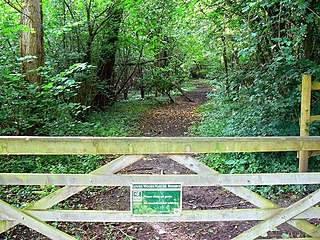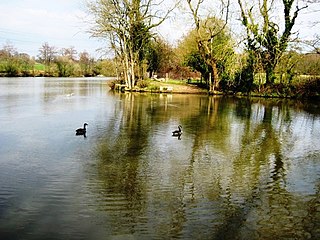
Bulkington is a large village and former civil parish near Bedworth, in the Nuneaton and Bedworth district of Warwickshire, England. In the 2011 census the ward had a population of 6,146 and 6,303 in the 2001 census. It is located around 6 miles (10 km) northeast of Coventry, just east of the towns of Nuneaton and Bedworth and 5 miles (8 km) southwest of Hinckley. Despite historically having stronger links with Bedworth, Bulkington forms part of the Nuneaton Urban Area. Bulkington was mentioned in the Domesday Book as Bochintone, meaning "estate associated with a man called Bulca".
Warwickshire Wildlife Trust is a Wildlife Trust and Registered Charity covering the county of Warwickshire and Solihull and Coventry in the county of West Midlands, England. The Trust aims to protect and enhance wildlife, natural habitats and geology throughout Warwickshire, Coventry and Solihull.

Wiltshire Wildlife Trust is a conservation charity based in Devizes, England which owns and manages 40 nature reserves in Wiltshire and Swindon. It also works to encourage Wiltshire's communities to live sustainable lifestyles that protect the environment.
The Cheshire Wildlife Trust (CWT) is a wildlife trust covering the county of Cheshire and parts of the counties of Greater Manchester and Merseyside, England. The trust's chairman is Bill Stothart. It manages 43 nature reserves totalling over 470 hectares, including:

Bubbenhall is a village and civil parish in the Warwick district of Warwickshire, England.

Lower Woods is a 280.1-hectare (692-acre) biological and geological Site of Special Scientific Interest near the village of Wickwar, South Gloucestershire, notified in 1966 and renotified in 1985. The site area has increased at last revision in 1974 to a 284.1-hectare (702-acre) site. The site is a nature reserve managed by the Gloucestershire Wildlife Trust.

Midger is a 65.7-hectare (162-acre) biological Site of Special Scientific Interest straddling the border of Gloucestershire and South Gloucestershire, notified in 1966 and renotified in 1984. Since the last revision in 1974, the size has been reduced to a 56-hectare (140-acre) site. It lies east of Hillesley, Gloucestershire and north of Hawkesbury Upton, South Gloucestershire. It is at the head of the Kilcott Valley.

Ryton Pools Country Park is a country park one mile south west of the village of Ryton on Dunsmore in Warwickshire, England. The park occupies an area of about 100 acres (0.40 km2) and contains four pools, the largest of which covers approximately 10 acres (40,000 m2). Professional park rangers are employed to look after the varied flora and fauna of the park as well as the general maintenance of pathways and buildings.
Monkspath Meadow is a 1.2 ha ancient hay-meadow and a biological site of Special Scientific Interest in the West Midlands. The site was notified in 1986 under the Wildlife and Countryside Act 1981. It is on the south-eastern edge of Monkspath. The site has recently been targeted for development for houses but these plans have been met with uproar from locals in Monkspath and nearby villages, such as Cheswick Green and Hockley Heath, as it would destroy such a special natural site.

Oak Hill Wood is a 10-hectare Local Nature Reserve (LNR) and a Site of Borough Importance for Nature Conservation Grade I, in East Barnet, London. It is owned by the London Borough of Barnet, and part of it is a 5.5-hectare nature reserve managed by the London Wildlife Trust.

Daneway Banks is a 17-hectare (42-acre) biological Site of Special Scientific Interest in Gloucestershire, notified in 1954 and renotified in 1983. It lies half a mile west of Sapperton and is part of a group of wildlife sites in the Frome Valley that includes Siccaridge Wood and Sapperton Canal reserves. The site is in the Cotswold Area of Outstanding Natural Beauty.

Foxley Wood is a nature reserve in Foxley, Norfolk, England, the largest ancient woodland and coppice in Norfolk. The Norfolk Wildlife Trust, which manages this reserve, bought it in 1998. It is 123 hectares in size. It is a Site of Special Scientific Interest, a Nature Conservation Review site, Grade 2, and a National Nature Reserve.

Hucclecote Meadows is a 5.74-hectare (14.2-acre) biological Site of Special Scientific Interest divided into two areas on each side of the M5 road in the Severn Vale, Gloucestershire. It was notified in 1984. The western area is also a Local Nature Reserve.

Cranham Brickfields is an 8.5 hectare Local Nature Reserve and a Site of Borough Importance for Nature Conservation, Grade I, in Cranham in the London Borough of Havering. It has an area of woodland with a pond, wildflower meadows, and a grassed area with a children's playground. The site was formerly used for excavating clay to make bricks, and during the Second World War vegetables were cultivated as part of the Dig for Victory campaign. Wildlife includes bullfinches, great crested newts, stag beetles and green hairstreak butterflies. There is also dyer's greenweed, which is rare in London.

Cranham Marsh is a 15.3 hectare Local Nature Reserve and a Site of Metropolitan Importance for Nature Conservation in Cranham in the London Borough of Havering. It is owned by Havering Council and managed by the Essex Wildlife Trust.

Ten Acre Wood is a Local Nature Reserve (LNR) in Yeading in the London Borough of Hillingdon, which is owned by Hillingdon Council and managed by the London Wildlife Trust (LWT). It is also part of the Yeading Brook Meadows Site of Metropolitan Importance for Nature Conservation (SINC), which includes two neighbouring LNRs managed by the LWT, Gutteridge Wood and Meadows and Yeading Brook Meadows LNR.

Yeading Brook Meadows is a 17 hectare Local Nature Reserve (LNR) in Yeading in the London Borough of Hillingdon. It is owned by Hillingdon Council and managed by the London Wildlife Trust (LWT). In the north it adjoins Ten Acre Wood across the Golden Bridge and Charville Lane; it then stretches south along the banks of the Yeading Brook to Yeading Lane. The reserve is also part of the Yeading Brook Meadows Site of Metropolitan Importance for Nature Conservation, which includes two neighbouring LNRs managed by the London Wildlife Trust, Ten Acre Wood and Gutteridge Wood and Meadows.

Bedelands Farm Nature Reserve is a 35.2-hectare (87-acre) Local Nature Reserve on the northern outskirts of Burgess Hill in West Sussex. It is owned and managed by Mid Sussex District Council. It site within the parish of Ansty and Staplefield. Since 1994, in consultation with the District Council and the University of Sussex, the Friends group have managing the area and for conservation of the flora and fauna and the public’s enjoyment. The Nature Reserve is a Site of Nature Conservation Importance (SNCI) and treasured by the local community. The richness of the area for wildlife is under threat by the encroaching housing developments of the Northern Arc and the pressures dog walking and other activities local housing will bear on the area.














